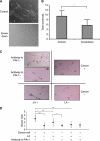Linoleic acid enhances angiogenesis through suppression of angiostatin induced by plasminogen activator inhibitor 1
- PMID: 22015554
- PMCID: PMC3242595
- DOI: 10.1038/bjc.2011.434
Linoleic acid enhances angiogenesis through suppression of angiostatin induced by plasminogen activator inhibitor 1
Abstract
Background: The intake of dietary fatty acids is highly correlated with the risk of various cancers. Linoleic acid (LA) is the most abundant polyunsaturated fat in the western diet, but the mechanism(s) by fatty acids such as LA modulate cancer cells is unclear. In this study, we examined the role of LA in various steps in gastric cancer progression.
Methods: The difference in gene expression between LA-treated and untreated OCUM-2MD3 gastric carcinoma cells was examined by mRNA differential display. The involvement of candidate genes was examined by oligo- and plasmid-mediated RNA interference. Biological functions of several of these genes were examined using in vitro assays for invasion, angiogenesis, apoptosis, cell viability, and matrix digestion. Angiogenesis in vivo was measured by CD-31 immunohistochemistry and microvessel density scoring.
Results: LA enhanced the plasminogen activator inhibitor 1 (PAI-1) mRNA and protein expression, which are controlled by PAI-1 mRNA-binding protein. LA-stimulated invasion depended on PAI-1. LA also enhanced angiogenesis by suppression of angiostatin, also through PAI-1. LA did not alter cell growth in culture, but increased dietary LA-enhanced tumour growth in an animal model.
Conclusion: Our findings suggest that dietary LA impacts multiple steps in cancer invasion and angiogenesis, and that reducing LA in the diet may help slow cancer progression.
Conflict of interest statement
The authors declare no conflict of interest.
Figures





Similar articles
-
Elevated dietary linoleic acid increases gastric carcinoma cell invasion and metastasis in mice.Br J Cancer. 2010 Oct 12;103(8):1182-91. doi: 10.1038/sj.bjc.6605881. Epub 2010 Sep 14. Br J Cancer. 2010. PMID: 20842125 Free PMC article.
-
Protumorigenic activity of plasminogen activator inhibitor-1 through an antiapoptotic function.J Natl Cancer Inst. 2012 Oct 3;104(19):1470-84. doi: 10.1093/jnci/djs377. Epub 2012 Sep 13. J Natl Cancer Inst. 2012. PMID: 22984202 Free PMC article.
-
Tumor development is retarded in mice lacking the gene for urokinase-type plasminogen activator or its inhibitor, plasminogen activator inhibitor-1.Cancer Res. 2000 Oct 15;60(20):5839-47. Cancer Res. 2000. PMID: 11059781
-
Angiostatin up-regulation in gastric cancer cell SGC7901 inhibits tumorigenesis in nude mice.World J Gastroenterol. 2003 Jan;9(1):59-64. doi: 10.3748/wjg.v9.i1.59. World J Gastroenterol. 2003. PMID: 12508352 Free PMC article.
-
The role of annexin II in angiogenesis and tumor progression: a potential therapeutic target.Curr Pharm Des. 2007;13(35):3568-75. doi: 10.2174/138161207782794167. Curr Pharm Des. 2007. PMID: 18220793 Review.
Cited by
-
Plasminogen activator inhibitor 1 RNAi suppresses gastric cancer metastasis in vivo.Cancer Sci. 2012 Feb;103(2):228-32. doi: 10.1111/j.1349-7006.2011.02155.x. Epub 2012 Jan 9. Cancer Sci. 2012. PMID: 22098548 Free PMC article.
-
Integrative Analysis of Nanopore and Illumina Sequencing Reveals Alternative Splicing Complexity in Pig Longissimus Dorsi Muscle.Front Genet. 2022 Apr 11;13:877646. doi: 10.3389/fgene.2022.877646. eCollection 2022. Front Genet. 2022. PMID: 35480309 Free PMC article.
-
Oral Administration of Linoleic Acid Induces New Vessel Formation and Improves Skin Wound Healing in Diabetic Rats.PLoS One. 2016 Oct 20;11(10):e0165115. doi: 10.1371/journal.pone.0165115. eCollection 2016. PLoS One. 2016. PMID: 27764229 Free PMC article.
-
Multi-omics analysis reveals that linoleic acid metabolism is associated with variations of trained immunity induced by distinct BCG strains.Sci Adv. 2024 Apr 5;10(14):eadk8093. doi: 10.1126/sciadv.adk8093. Epub 2024 Apr 5. Sci Adv. 2024. PMID: 38578989 Free PMC article.
-
Linoleic Acid-Induced Growth Inhibition of Human Gastric Epithelial Adenocarcinoma AGS Cells is Associated with Down-Regulation of Prostaglandin E2 Synthesis and Telomerase Activity.J Cancer Prev. 2014 Mar;19(1):31-8. doi: 10.15430/jcp.2014.19.1.31. J Cancer Prev. 2014. PMID: 25337570 Free PMC article.
References
-
- Astrup A (2005) The role of dietary fat in obesity. Sem Vasc Med 5: 40–47 - PubMed
-
- Bajou K, Maillard C, Jost M, Lijnen RH, Gils A, Declerck P, Carmeliet P, Foidart JM, Noel A (2004) Host-derived plasminogen activator inhibitor-1 (PAI-1) concentration is critical for in vivo tumoral angiogenesis and growth. Oncogene 23: 6986–6990 - PubMed
-
- Bajou K, Noel A, Gerard RD, Masson V, Brunner N, Holst-Hansen C, Skobe M, Fusenig NE, Carmeliet P, Collen D, Foidart JM (1998) Absence of host plasminogen activator inhibitor 1 prevents cancer invasion and vascularization. Nat Med 4: 923–928 - PubMed
-
- Banfi C, Rise P, Mussoni L, Galli C, Tremoli E (1997) Linoleic acid enhances the secretion of plasminogen activator inhibitor type 1 by HepG2 cells. J Lipid Res 38: 860–869 - PubMed
-
- Brooks TD, Wang SW, Brunner N, Charlton PA (2004) XR5967, a novel modulator of plasminogen activator inhibitor-1 activity, suppresses tumor cell invasion and angiogenesis in vitro. Anticancer Drugs 15: 37–44 - PubMed
Publication types
MeSH terms
Substances
Grants and funding
LinkOut - more resources
Full Text Sources
Medical
Miscellaneous

